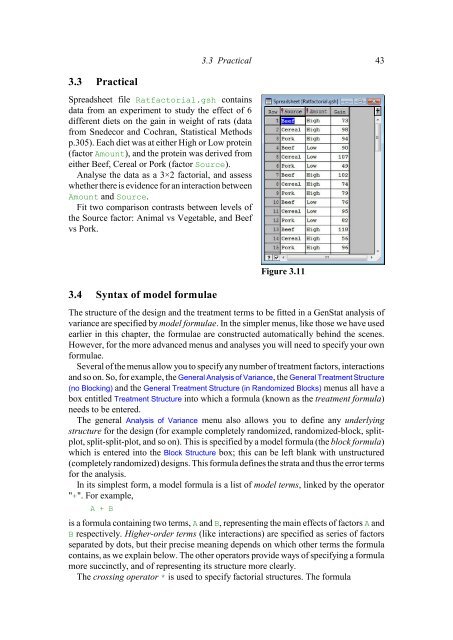Download pdf guide - VSN International
Download pdf guide - VSN International
Download pdf guide - VSN International
You also want an ePaper? Increase the reach of your titles
YUMPU automatically turns print PDFs into web optimized ePapers that Google loves.
3.3 Practical 433.3 PracticalSpreadsheet file Ratfactorial.gsh containsdata from an experiment to study the effect of 6different diets on the gain in weight of rats (datafrom Snedecor and Cochran, Statistical Methodsp.305). Each diet was at either High or Low protein(factor Amount), and the protein was derived fromeither Beef, Cereal or Pork (factor Source).Analyse the data as a 3×2 factorial, and assesswhether there is evidence for an interaction betweenAmount and Source.Fit two comparison contrasts between levels ofthe Source factor: Animal vs Vegetable, and Beefvs Pork.Figure 3.113.4 Syntax of model formulaeThe structure of the design and the treatment terms to be fitted in a GenStat analysis ofvariance are specified by model formulae. In the simpler menus, like those we have usedearlier in this chapter, the formulae are constructed automatically behind the scenes.However, for the more advanced menus and analyses you will need to specify your ownformulae.Several of the menus allow you to specify any number of treatment factors, interactionsand so on. So, for example, the General Analysis of Variance, the General Treatment Structure(no Blocking) and the General Treatment Structure (in Randomized Blocks) menus all have abox entitled Treatment Structure into which a formula (known as the treatment formula)needs to be entered.The general Analysis of Variance menu also allows you to define any underlyingstructure for the design (for example completely randomized, randomized-block, splitplot,split-split-plot, and so on). This is specified by a model formula (the block formula)which is entered into the Block Structure box; this can be left blank with unstructured(completely randomized) designs. This formula defines the strata and thus the error termsfor the analysis.In its simplest form, a model formula is a list of model terms, linked by the operator"+". For example,A + Bis a formula containing two terms, A and B, representing the main effects of factors A andB respectively. Higher-order terms (like interactions) are specified as series of factorsseparated by dots, but their precise meaning depends on which other terms the formulacontains, as we explain below. The other operators provide ways of specifying a formulamore succinctly, and of representing its structure more clearly.The crossing operator * is used to specify factorial structures. The formula
















